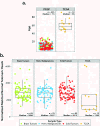Assessing telomeric DNA content in pediatric cancers using whole-genome sequencing data
- PMID: 23232254
- PMCID: PMC3580411
- DOI: 10.1186/gb-2012-13-12-r113
Assessing telomeric DNA content in pediatric cancers using whole-genome sequencing data
Abstract
Background: Telomeres are the protective arrays of tandem TTAGGG sequence and associated proteins at the termini of chromosomes. Telomeres shorten at each cell division due to the end-replication problem and are maintained above a critical threshold in malignant cancer cells to prevent cellular senescence or apoptosis. With the recent advances in massive parallel sequencing, assessing telomere content in the context of other cancer genomic aberrations becomes an attractive possibility. We present the first comprehensive analysis of telomeric DNA content change in tumors using whole-genome sequencing data from 235 pediatric cancers.
Results: To measure telomeric DNA content, we counted telomeric reads containing TTAGGGx4 or CCCTAAx4 and normalized to the average genomic coverage. Changes in telomeric DNA content in tumor genomes were clustered using a Bayesian Information Criterion to determine loss, no change, or gain. Using this approach, we found that the pattern of telomeric DNA alteration varies dramatically across the landscape of pediatric malignancies: telomere gain was found in 32% of solid tumors, 4% of brain tumors and 0% of hematopoietic malignancies. The results were validated by three independent experimental approaches and reveal significant association of telomere gain with the frequency of somatic sequence mutations and structural variations.
Conclusions: Telomere DNA content measurement using whole-genome sequencing data is a reliable approach that can generate useful insights into the landscape of the cancer genome. Measuring the change in telomeric DNA during malignant progression is likely to be a useful metric when considering telomeres in the context of the whole genome.
Figures




References
Publication types
MeSH terms
Substances
Grants and funding
LinkOut - more resources
Full Text Sources
Molecular Biology Databases

